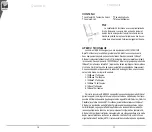
2
English
3
English
bOX cOntEntS
•
LanMaster 26 Link Tester
•
RJ-45 Coupler
•
9 Volt Alkaline Battery
•
User Guide
battERY
The LanMaster 26 operates on one 9 volt alkaline
battery. Remove the battery cover at the bottom
of the unit and insert the battery with the terminal
orientation as shown. Battery polarity is marked on
the back of the battery cover and inside the battery
well for reference.
tEcHnIcal OVERVIEW
The IEEE 802.3 Standards require 10/100/1000 BaseTX LAN equipment
to use a signaling system to establish a Link between two devices called Link
Partners. 10BaseT Ethernet devices typically use a Normal Link Pulse to
establish the Link. 100/1000 BaseT Ethernet equipment (and some 10BaseT
products) use a burst of Fast Link Pulses (FLPs) to transmit a Link Code
Word defining the capabilities of the device. If both Link Partners have Auto-
negotiation capability, a Link is established based on the following priority:
1. 1000BaseTX Full Duplex
2. 1000BaseTX Half Duplex
3. 100BaseTX Full Duplex
4. 100BaseTX Half Duplex
5. 10BaseT Full Duplex
6. 10BaseT Half Duplex
The IEEE 802.3 Standards do not require Ethernet equipment to support
Auto-negotiation or more than one speed or duplex mode. A second type of
signaling called Parallel Detection (a continuous MLT-3 waveform) can also
be used to establish a 100BaseT Ethernet Link. Parallel Detection signaling
does not differentiate between half duplex and full duplex mode which can
lead to poor network performance if both Link Partners are not properly
configured. Ethernet LAN equipment that has been manually configured to a
specific speed and duplex mode may establish a Link with a Link Code Word,
an NLP or a Parallel Detection (MLT-3) signal. Knowing the type of signaling
used on a Link is essential to optimizing system performance.The LanMaster
26 detects and decodes the different Link signals on 10/100/1000BaseT
Ethernet networks and displays the equipment configuration signaling type.
The LanMaster 26 also tests Power over Ethernet (PoE) as defined by IEEE
Standard 802.3af and VoIP ports for voltage levels.
OPERatIOn
The LanMaster 26 test consists of four steps:
(1) detecting and measuring a powered Ethernet port (PoE);
(2) detecting a VoIP port, turning on and measuring the voltage;
(3) detecting Link signals;
(4) transmitting Link signals.
Insert the LanMaster 26 plug end in to the RJ-45 port of a hub, switch,
network interface card, wall outlet, or attach to a UTP or STP cable with the
RJ-45 coupler.
Press and release the “TEST” button. The VoIP/PoE indicator will start
blinking while the wire pairs are scanned for voltage. When a voltage of
40VDC or more is detected, the indicator will
illuminate green continuously. If the voltage
is between 18VDC and 40VDC the indica-
tor will illuminate red continuously. (A device
connected to a port that is providing less than
40VDC is unlikely to operate properly.)
When no voltages above 18 VDC are
detected, the LanMaster 26 tests for a VoIP
port. When VoIP Link Signals are received, the
required signals are sent back to the port to
turn on the power. The indicator illuminates green or red continuously at the
same voltage levels as a PoE port described above.
After the VoIP test times out, the LAN and NIC indicators start blinking
while the wire pairs are scanned for Ethernet Link Signals. Link signals de-
tected on wire pair 3,6 will illuminate the LAN indicator green continuously. Link
signals detected on wire pair 1,2 will illuminate
the NIC indicator green continuously. Link sig-
nals detected on both wire pairs will illuminate
the LAN and NIC indicators green continuously
showing the port has auto switching capability.
When Link signals are detected on a wire pair,
the indicator(s) for the speed and duplex modes
are illuminated. After one second, the LanMas-
ter 26 automatically transmits a pattern of Link
signals to the Link Partner (LAN indicator blinks
as the signals are transmitted for a LAN or auto switching port, NIC indicator
blinks for a NIC port). The Link indicator on the hub or switch at the far end will
also blink indicating which port is connected to the LanMaster 26. (Hubs/switch-
es have different Link indicator time delays. The blink rate of the equipment








